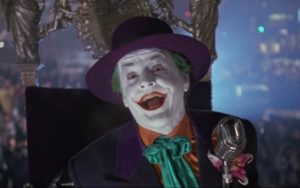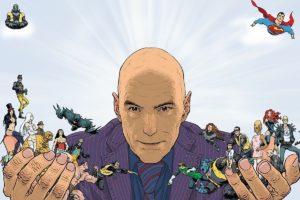…continued from Building Timelines for Dummies/A Few Parting Words…
_______________________________
_______________________________________________________________________________________
_______________________________
WHO I AM, HOW I CAME TO BE
I don’t often get into my own personal history on the website, but I did do a lovely interview with Steve Lemlek on Unleash the Fanboy that answers a lot of personal stuff if you’d like to learn more about my background. But here’s a bit more in that vein to sate my patrons.

Batman (1989)—directed by Tim Burton, cinematography by Roger Pratt.
My passion for superhero comics started when, as a five-year-old, I was gifted a treasure trove of random comics, including some great Frank Miller and Peter Milligan single issues, which were my first dip into the medium. After that, my history with Batman probably isn’t all that different from a lot of people that grew up in the 1980s or 1990s. I was an impressionable six-year-old when Tim Burton’s Batman was released in theaters. I couldn’t have been more enamored. And I was still impressionable when Batman the Animated Series first aired three years later. That show definitely got me hooked on Batman more than anything else, although I was still mostly unfamiliar with the comics version of the character. My interest, then, turned to collecting DC and Marvel trading cards for a few years. But due to Warner Bros holding the copyright license to Batman back in those days, the DC cards never included the Dark Knight or his rogues. Having very few Batman comics of my own—and being more into Star Wars and Marvel as a kid, I still didn’t know much about the Caped Crusader’s vast narrative history. It was the criminally underrated Superman the Animated Series that got me obsessed with the shared comic book world of the DCU, which ironically led me into the paper world of Batman! DC owes so much more to Bruce Timm, Paul Dini, and Alan Burnett then they will ever acknowledge. By the time the final amazing seasons of Superman the Animated Series aired from 1998 to 2000, I was in my mid-teens and it was much easier for me to visit the local comic book shops and graphic novel section of the big chain bookstore, now specifically seeking out material that matched the amazing characters from the Superman show. I immediately devoured Cosmic Odyssey, The Dark Knight Returns, and all of “Knightfall,” and then I was all-in forever.

The Batman Chronology Project 1.0 aka The Real Batman Chronology Project (on Blogger)
Over time, my reason for loving superhero comics expanded to include many things—the characters, costumes, sci-fi weirdness, drama, art, social commentary, cultural critique, shark-jumping, and world-building. And this led me to create the Batman Chronology Project (originally known as the Real Batman Chronology Project). When it was first conceived in 2009, the goal of the project was to document the process of reading every single Modern Age Batman comic book. However, after I began reading I quickly realized that DC publishes a lot of monthly comic books that feature Batman, but they don’t tell you in what order to read them or how to organize them. And you can’t simply read them in the order they were published. It’s way more complex. When I inaugurated my princeps, I was frustrated with the lack of legit timelines online (aside from Chris J Miller’s Unauthorized Chronology of the DC Universe, which was one of the biggest inspirations). Miller’s work was nothing short of genius and, if not for him, I’d have been lost from the start. Thus, using Miller as a guide, an adventure in comic book reading morphed into an attempt to stratify every Modern Age Batman appearance into chronological narrative reading order. I soon developed an idée fixe in understanding how a myriad of individual comic books fit together. How could this chaotic bricolage—hundreds of thousands of comic book titles, all drawn and written by various creators—possibly function as a cohesive narrative, especially over the course of decades? When faced with the kaleidoscopic farrago, the comics coalesced to form a vast puzzle. Piecing together this puzzle became the focus of the Batman Chronology Project, which allowed me to conduct various research-based projects in regard to Continuity with a Capital C. The blog contained within the site (formerly called disCONTINUITY) also provided a space for commentaries on comic book narrative, authorship, fandom, culture, and news.

Grant Morrison as drawn by Frank Quitely
If there’s a single comic book author that has most influenced and inspired me, it’s without-a-doubt Grant Morrison. Analyst Keith Scott, in his article “No Guru, No Method, No Teacher”, sums up part of my admiration and fascination with Morrison by saying, “Comics studies must embrace a multimodal, multidisciplinary approach, regarding the form as something approaching a true Gesamtkunstwerk, and Morrison’s work is particularly fruitful for study in this vein, as it continually plays on the interaction between image and text, and the relationship between physical artefact and the reader.” Morrison’s first few years writing Batman (2006 through 2010, especially) reaffirmed my love of superhero comics (and Batman) at a time when my interest was honestly starting to fade. Morrison has said they’ve always looked at a character’s published adventures as the continuing story of that person’s experience, which is why I initially gave my project the “Real” prefix. “Real” meant a view from this very perspective.
With Morrison (and many influences from my NYU Masters program in cinema studies) guiding me, the Batman Chronology Project evolved into an exegesis about something broader than just Batman—the site began addressing the complexity of all serialized storytelling. When we read (or create) serialized narratives, we engage in a perceptive (or creative) process that is quite unlike any other. Today, my project serves to analyze and catalogue this phenomenon. Some fans (maybe most fans) might have little interest in a deep dive like this. For some fans (maybe most fans), a deep dive like this can actually ruin the type of engagement they have with comics and superheroes (i.e. an intensely “fun and carefree” type of fandom, but one that is less analytic). For example, some fans (maybe most fans) might consider my project as having as much worth (or worthlessness) as Tim Leong’s Super Graphic, which contains detailed infographics, charts, and diagrams connecting random threads from within pop culture. I’m not trying to yuck anyone’s yum or draw attention to flaws or inconsistencies. For me, doing a deep dive is a labor of love that shows superhero comics as they are—warts and all—and always makes me care for them even more. I hope you feel the same way!
_______________________________________________________________________________________
Special thanks to Ashley Jean Mastrine and Ross Holtry for supporting me from the awkward beginning, and to the late great Steve Herb for lifting me up as well. Thanks also for the multitude of divers hands assistance that I’ve received along the way from countless friends and strangers alike. And thanks for the financial support from Angus Livingstone, GhostHeart1993, and Sarah.
_______________________________
_______________________________
_______________________________________________________________________________________
_______________________________

